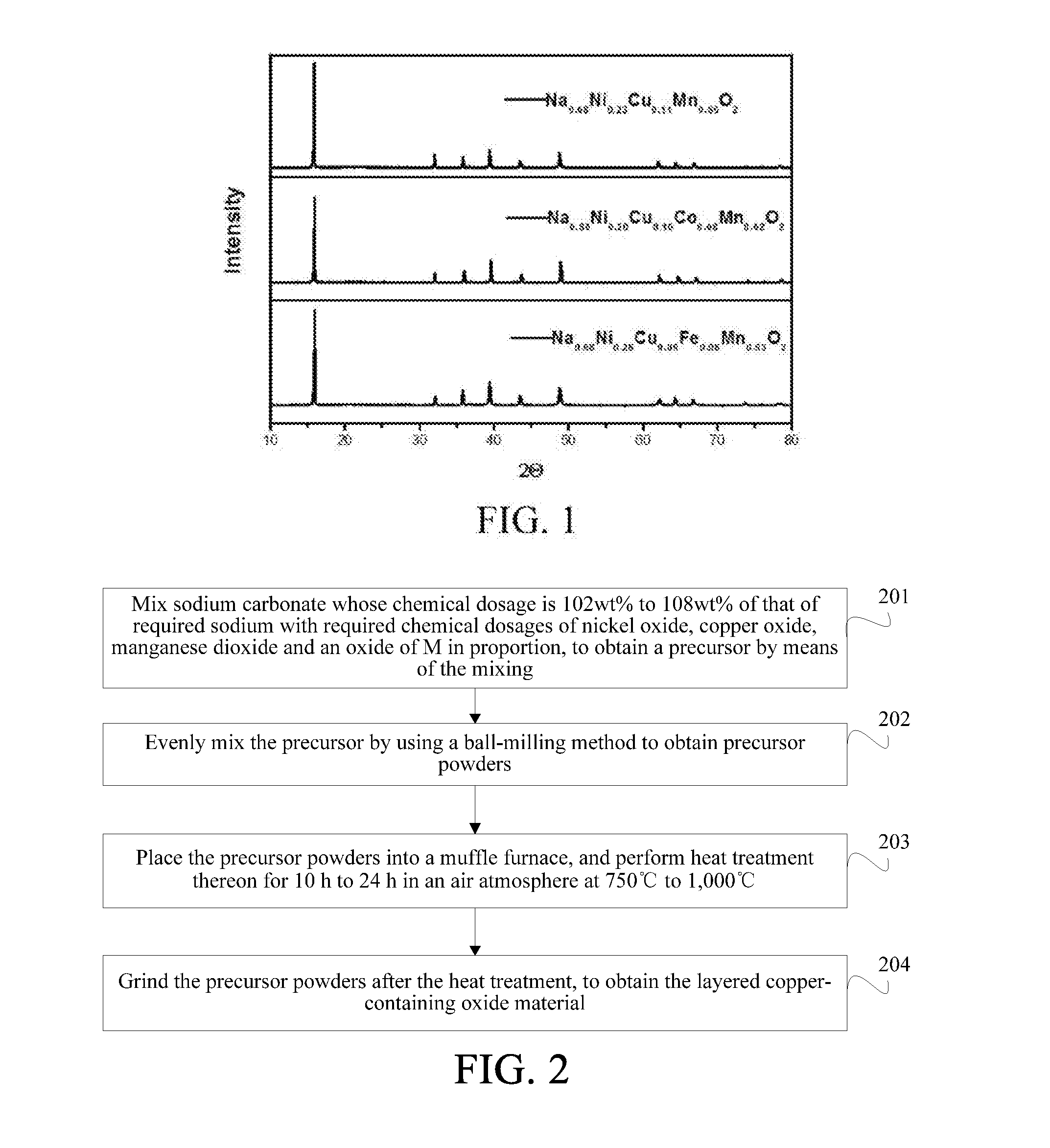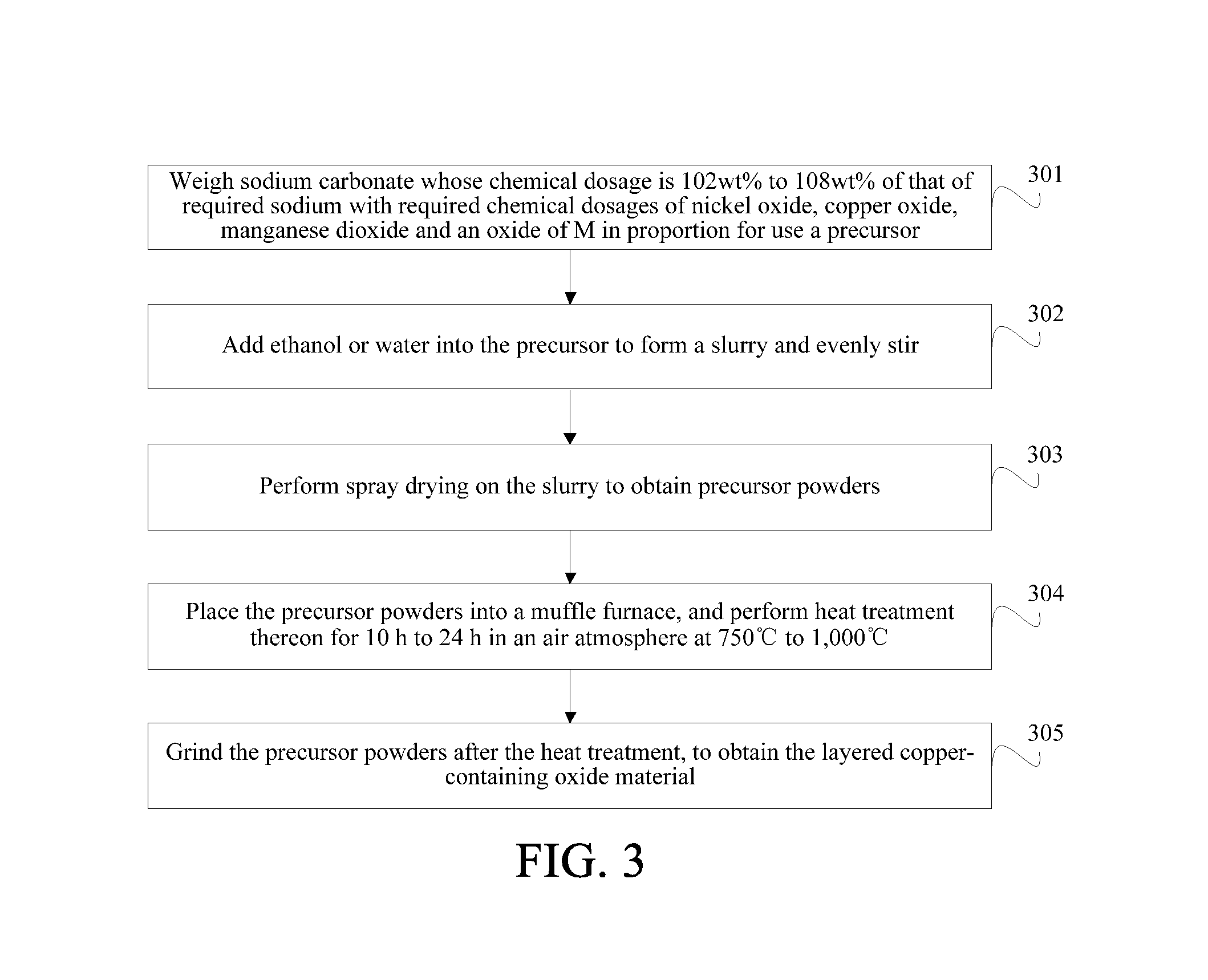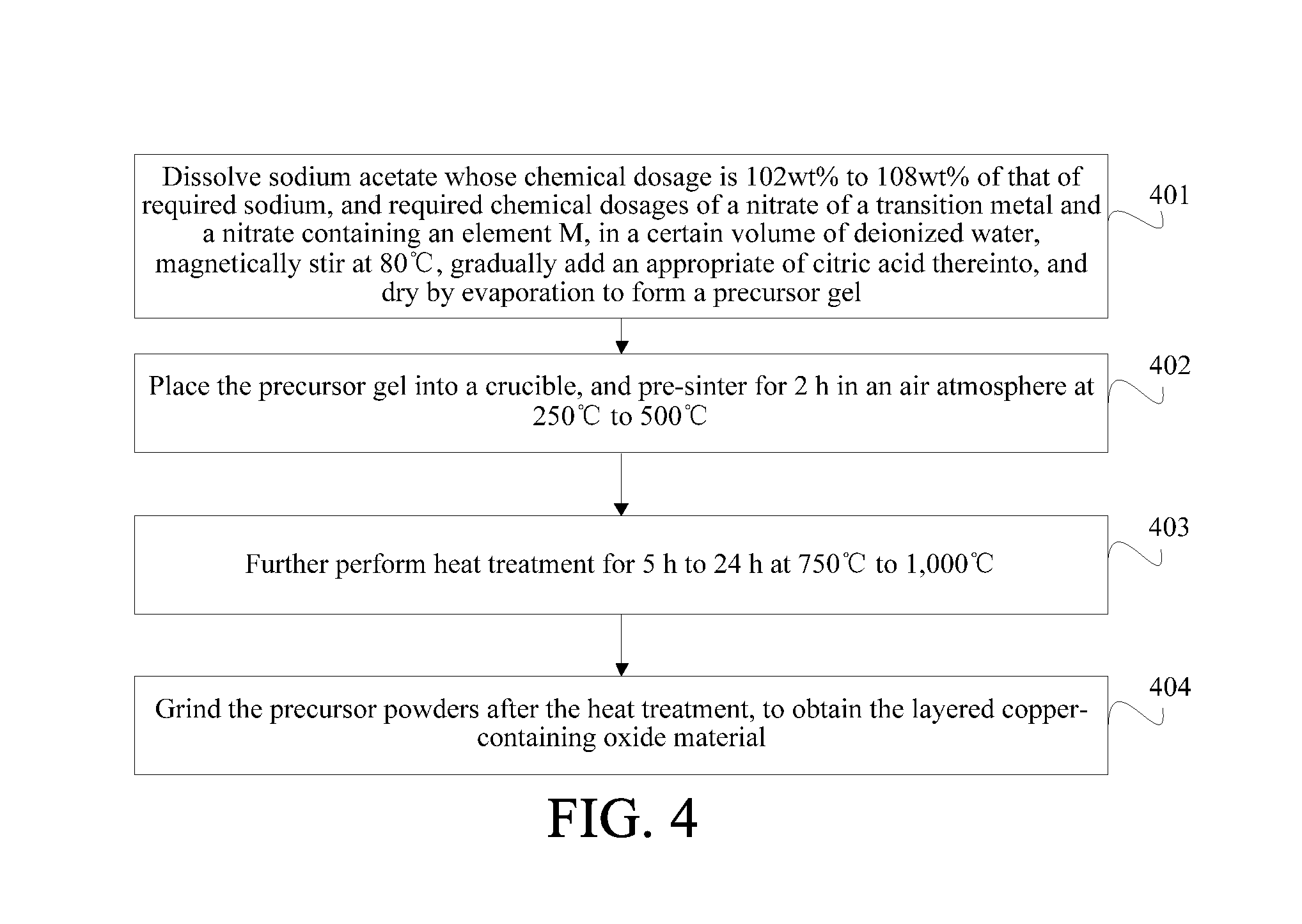Layered copper-containing oxide material and preparation process and purpose thereof
a technology of copper-containing oxide and preparation process, which is applied in the field of material technology, can solve the problems of high cost of lithium-ion batteries, inability to meet large-scale application requirements for low cost, and inability to achieve high voltage, etc., and achieves simple preparation process, low cost, and abundant raw material resources
- Summary
- Abstract
- Description
- Claims
- Application Information
AI Technical Summary
Benefits of technology
Problems solved by technology
Method used
Image
Examples
embodiment 1
[0051]Embodiment 1 of the present invention provides a layered copper-containing oxide material, with a general chemical formula of Na0.68+aNibCucMdMneO2+δ,
[0052]where, Ni, Cu and Mn are transition metal elements, M is an element that performs doping and substitution on transition metal complexation, and M is specifically one or more of Mg2+, Mn2+, Zn2+, Co2+, Al3+, B3+, Cr3+, Mn3+, Co3+, V3+, Zr4+, Ti4+, Sn4+, Mo4+, Ru4+, Nb4+, Sb5+, Nb5+, Mo6+, and Te6+; and a valence of M is m, where m is specifically univalence, bivalence, trivalence, tetravalence, pentavalence or sexavalence; and
[0053]a, b, c, d, e and δ are respectively molar percentages occupied by corresponding elements; and relationships between a, b, c, d, e, δ, and m meet (0.68+a)+2(b+c)+md+4e=2(2+δ), and also meet b+c+d+e=1, where −0.08≦a≦0.08; 0<b≦0.38; 0<c<0.38; 0≦d<0.36; 0<e≦0.7; and −0.02<δ<0.02.
[0054]In the structure of Na0.68+aNibCucMdMneO2+δ, Ni, Cu, M and Mn respectively form octahedral structures together with s...
embodiment 2
[0057]This embodiment provides a preparation process of a layered copper-containing oxide material, which is specifically a solid phase method. As shown in FIG. 2, the process includes:
[0058]Step 201: Mix sodium carbonate whose chemical dosage is 102 wt % to 108 wt % of that of required sodium with required chemical dosages of nickel oxide, copper oxide, manganese dioxide and an oxide of M in proportion, to obtain a precursor by means of the mixing.
[0059]Specifically, M may be one or more of Mg2+, Mn2+, Zn2+, Co2+, Al3+, B3+, Cr3+, Mn3+, Co3+, V3+, Zr4+, Ti4+, Sn4+, Mo4+, Ru4+, Nb4, Sb5+, Nb5+, Mo6+, and Te6+.
[0060]Step 202: Evenly mix the precursor by using a ball-milling method to obtain precursor powders.
[0061]Step 203: Place the precursor powders into a muffle furnace, and perform heat treatment thereon for 10 h to 24 h in an air atmosphere at 750° C. to 1,000° C.
[0062]Step 204: Grind the precursor powders after the heat treatment, to obtain the layered copper-containing oxide m...
embodiment 3
[0064]This embodiment provides a preparation process of a layered copper-containing oxide material, which is specifically a spray drying method. As shown in FIG. 3, the process includes:
[0065]Step 301: Weigh sodium carbonate whose chemical dosage is 102 wt % to 108 wt % of that of required sodium with required chemical dosages of nickel oxide, copper oxide, manganese dioxide and an oxide of M in proportion for use a precursor.
[0066]Specifically, M may be one or more of Mg2+, Mn2+, Zn2+, Co2+, Al3+, B3+, Cr3+, Mn3+, Co3+, V3+, Zr4+, Ti4+, Sn4+, Mo4+, Ru4+, Nb4+, Sb5+, Nb5+, Mo6+, and Te6+.
[0067]Step 302: Add ethanol or water into the precursor and evenly stir to form a slurry.
[0068]Step 303: Perform spray drying on the slurry to obtain precursor powders.
[0069]Step 304: Place the precursor powders into a muffle furnace, and perform heat treatment thereon for 10 h to 24 h in an air atmosphere at 750° C. to 1,000° C.
[0070]Step 305: Grind the precursor powders after the heat treatment, t...
PUM
| Property | Measurement | Unit |
|---|---|---|
| particle size distribution | aaaaa | aaaaa |
| Coulombic efficiency | aaaaa | aaaaa |
| charge cut-off voltage | aaaaa | aaaaa |
Abstract
Description
Claims
Application Information
 Login to View More
Login to View More - R&D
- Intellectual Property
- Life Sciences
- Materials
- Tech Scout
- Unparalleled Data Quality
- Higher Quality Content
- 60% Fewer Hallucinations
Browse by: Latest US Patents, China's latest patents, Technical Efficacy Thesaurus, Application Domain, Technology Topic, Popular Technical Reports.
© 2025 PatSnap. All rights reserved.Legal|Privacy policy|Modern Slavery Act Transparency Statement|Sitemap|About US| Contact US: help@patsnap.com



